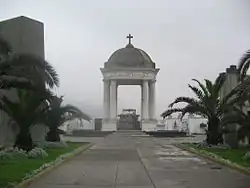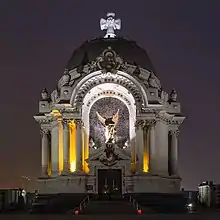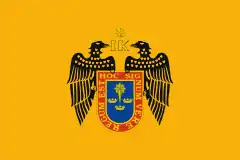Cementerio Presbítero Matías Maestro
Presbyter Matías Maestro Cemetery (Spanish: Cementerio Presbítero Matías Maestro),[1] formerly the General Cemetery of Lima (Spanish: Cementerio General de Lima), is a cemetery, museum and historical monument located in the Barrios Altos neighbourhood of Lima District, in Lima, Peru. Inaugurated on May 31, 1808, it was the first pantheon in the city since burials were previously held in the city's churches. It was named in honour of its designer, Spanish priest Matías Maestro.
| Cementerio Presbítero Matías Maestro | |
|---|---|
 | |
| Details | |
| Established | 1810 |
| Location | |
| Owned by | Charity of Lima |
| Find a Grave | Cementerio Presbítero Matías Maestro |
Its 766 mausoleums and 92 historical monuments of the most refined architecture of the 19th and 20th centuries keep the remains of several important political, military and literary figures of Peru, as well as the Crypt of Heroes (Spanish: Cripta de los Héroes) monument, a mausoleum erected in honor of the heroes of the War of the Pacific.
History
The General Cemetery of Lima was the first civil cemetery in America. It was initially faced with the opposition of the population that was accustomed to burying their dead in the atrium or under the churches and convents in crypts or catacombs. Its inauguration in 1808 was headed by Viceroy José Fernando de Abascal, under the direction of the Vitorian architect, sculptor and painter Matías Maestro. Maestro travelled to Peru by the end of the 18th century to start a new business. In 1793, he became a Catholic Priest and since then he dedicated himself to “renewing” the churches and altarpieces with the latest fashion style: Neoclassical. He became General Director of Lima's Public Beneficence Society in 1826 and died on January 7, 1835.
The cemetery was executed with care, within the guidelines of the new style: symmetry, irradiation of the new barracks, chapels, parks, avenues laid out in an orderly and clear manner. An octagonal chapel was designed for this cemetery, later demolished. Its interior was decorated with murals by José del Pozo, a Sevillian painter who arrived with the Malaspina expedition who settled in Lima and became a close collaborator of Maestro.
In the early hours of Sunday, November 4, 1917, José Carlos Mariátegui together with other people, among them the dancer Norka Rouskaya, caused a scandal,[2] since Rouskaya danced half-naked on the main avenue between candles and violins in the Funeral March of Frédéric Chopin.[3][4]
Construction
In this place there are many works by the Spanish Damià Campeny and the French Louis-Ernest Barrias, Émile Robert and Antonin Mercié (the latter two worked in the Crypt of Heroes). Also included are the works of the Italians Ulderico Tenderini, Giovanni Battista Cevasco, Pietro Costa and Rinaldo Rinaldi, all well-known in the artistic world of their time. Likewise, it is possible to appreciate works by prominent Peruvian sculptors of the mid-20th century, such as the funeral monument to Luis Miguel Sánchez Cerro, by Romano Espinoza; the bronze sculptures of the mausoleum of Óscar R. Benavides, by Luis Agurto; the mausoleum of Eloy G. Ureta, by Artemio Ocaña; the angel of the funeral monument to Francisco Graña, by Aldo Rossi; and the Pastor Fry mausoleum, by Eduardo Gastelú. The sculpture of the cenotaph of Alfonso Ugarte is the work of the Spanish sculptor Josep Campeny i Santamaria.
Among the works of art that are part of the cemetery are El Ángel de la Guarda (1947) by the sculptor Isabel Benavides Barreda.
Cripta de los Héroes
Cripta de los Héroes | |
 The mausoleum at night | |
| Designer | Emile Robert |
|---|---|
| Type | Mausoleum |
| Material | Stone, marble |
| Opening date | September 8, 1908 |
| Restored date | 2002 |
| Dedicated to | War of the Pacific |
The Crypt of Heroes (Spanish: Cripta de los Héroes) is the cemetery's largest monument, built to commemorate those fallen during the War of the Pacific.[5][6] The mausoleum's entrance reads "La Nación a sus Defensores en la Guerra de 1879" (Meaning "The Nation, to its Defenders in the War of 1879").[7]
History
It was created by Law on December 3, 1906 and inaugurated on September 8, 1908 during the government of José Pardo y Barreda. The budget was stipulated at Lp. 8,000.[8] The work was executed in stone and marble by the architect Emile Robert with a marked eclectic style[9] and crowned with a marble reproduction of the Gloria Victis, the work of the sculptor Antonin Mercié.[10]
By Supreme Decree No. 13-GM of October 1, 1953, it was decided to integrate it under the custody of the Center for Historical Military Studies of Peru, as a Patriotic Sanctuary. On July 25, 1986, the monument was expanded to bury the remains of more combatants, adding a second basement.[9]
In 2002 restoration work was carried out to return it to its original appearance.[9]
Controversy
Despite having been conceived and erected to contain the remains of combatants from the War of the Pacific, the remains of figures who participated in that conflict but who did not die in combat, such as Andrés Avelino Cáceres or Miguel Iglesias, have been buried in the mausoleum.[7]
In 1987, Alipio Ponce Vásquez, a combatant in the 1941 Ecuadorian–Peruvian War, was declared a national hero through Law No. 24658, which granted him the title, and also provided for his burial in the mausoleum. This did not happen due to the mausoleum being of exclusive use for participants in the War of 1879. In 2005, the Peruvian Congress authorized the burial of the remains of Major Luis Alberto García Rojas, killed in the Cenepa War, which took place in 1997.[7]
On the other hand, there are commemorative plaques that remember heroes of other wars, such as César Pinglo Pinglo and Bernardo Villalta Luna (who died in the Battle of La Pedrera of 1911), and José Quiñones Gonzales and Alipio Ponce (of the Ecuadorian–Peruvian War of 1941).[7]
Description
The Crypt of Heroes is a circular mausoleum over 30 metres high, with three levels, one main and two basements.[11] It has a large dome that crowns it, and is surrounded by ornaments and neoclassical columns. Inside it is covered in marble with black veining; stained glass windows were also added.[8]
In total, it contains 295 identified remains, 29 of them in sarcophagi and 265 in niches, as well as 2,065 wall plaques with names of combatants or unidentified victims.[9]
Main floor
This level, which is the entrance to the mausoleum, is finely covered in marble. The sarcophagi of the greatest Peruvian heroes of the war are: Miguel Grau, who died in the battle of Angamos on October 8, 1879 aboard the Huáscar armour-clad monitor, and Colonel Francisco Bolognesi, defender of Arica, who fell in battle on June 7, 1880. In addition, marble plaques with the names of people who supported or participated in the conflict have been installed on the walls.[8]
First basement
In the first basement, which is accessed by a side staircase, remains were buried in 234 niches scattered around the entire contour. In the central part appears the sarcophagus of Mariscal Andrés Avelino Cáceres. There are also five ossuaries which contain remains of anonymous combatants who died during the naval battles in Angamos, Iquique, Antofagasta and Callao, and those found on the battlefields of Tarapacá, Tacna and Arica, San Juan and Chorrillos, Miraflores, Huamachuco and San Pablo.[8]
Second basement
On the last level there are 29 sarcophagi, 16 plaques and 40 white marble niches that contrast with the black marble on the floor and walls. Here lie Alfonso Ugarte and other heroes of the War of the Pacific, as well as the remains of Luis Alberto García Rojas, buried in 2019.[8]
Notable burials
Heads of state
- José de la Riva Agüero (mausoleum)
- José de La Mar (mausoleum)
- Agustín Gamarra (mausoleum)
- Antonio Gutiérrez de la Fuente
- Andrés Reyes y Buitrón
- Manuel Salazar y Baquíjano (mausoleum)
- Pedro Pablo Bermúdez
- Felipe Santiago Salaverry (mausoleum)
- Juan Crisóstomo Torrico (mausoleum)
- Domingo Elías
- Juan Antonio Pezet
- Justo Figuerola
- Manuel Menéndez
- Juan Manuel del Mar
- José María Raygada y Gallo
- Manuel Ignacio de Vivanco
- José Rufino Echenique
- José Balta y Montero
- Miguel de San Román (mausoleum)
- Manuel Pardo y Lavalle (mausoleum)
- Mariano Ignacio Prado (mausoleum)
- Nicolás de Piérola (mausoleum)
- Lizardo Montero (Crypt of Heroes)
- Miguel Iglesias (Crypt of Heroes)
- Remigio Morales Bermúdez (Crypt of Heroes)
- Justiniano Borgoño (Crypt of Heroes)
- Andrés Avelino Cáceres (Crypt of Heroes)
- Manuel Candamo (mausoleum)
- José Pardo y Barreda
- Guillermo Billinghurst (mausoleum)
- Augusto B. Leguía (mausoleum)
- Luis Miguel Sánchez Cerro (mausoleum)
- Óscar R. Benavides (mausoleum)
- Manuel Prado Ugarteche (mausoleum)
- Ricardo Pérez Godoy
Politicians
- Antonia Moreno Leyva (first lady)
- Victoria Tristán (first lady)
- Vicente Rocafuerte
- Francisco Escudero
- Edgardo Seoane
- Victor Larco Herrera
- Eugenio Larrabure y Unanue
- Anita Fernandini de Naranjo
- Genaro Castro Iglesias
- Pío de Tristán
- Javier Diez Canseco
- Luis A. Flores
- José Gálvez Egúsquiza
Academics
Military
- Alfonso Ugarte (mausoleum)
- Eloy G. Ureta (mausoleum)
- Alfredo Rodríguez Ballón
- Juan Crisóstomo de Mendiburu y Salazar
- Clemens von Althaus
- Manuel Bonilla Elhart
Artists and sportsmen
- Felipe Pardo y Aliaga (writer)
- Manuel Ascencio Segura (writer)
- Manuel González Prada (writer)
- Ricardo Palma (writer)
- Ricardo Rossel (writer)
- Abraham Valdelomar (writer)
- José Carlos Mariátegui (writer)
- José Santos Chocano (writer)
- María Wiesse (writer)
- Ciro Alegría (writer)
- José María Eguren (writer)
- César Moro (writer)
- Francisco Laso (painter)
- José Sabogal (painter)
- Víctor Humareda (painter)
- Felipe Pinglo Alva (composer)
- Carlos Hayre (composer)
- Rosa Merino (singer)
- Micaela Villegas (singer)
- Alejandro Villanueva (sportsman)
Architects, engineers and businessmen
- Matías Maestro
- Edward Jan Habich
- Ernest Malinowski
- Henry Meiggs
- Michele Trefogli
- Manuel Piqueras Cotolí
- Francisco Graña Garland
- Rollin Thorne Sologuren
- Eulogio Fernandini
- Genaro Barragán Urrutia
- Roberto Letts
In popular culture
For several years at the time of All Saints' Day, the play Don Juan Tenorio by José Zorrilla, a classic of literature written in Spanish, has been represented in the Cemetery.
Gallery
 El Panteón de los Próceres
El Panteón de los Próceres The cemetery at night
The cemetery at night
See also
References
- Sánchez Rodríguez, Lucía Isabel (2020). Características arquitectónicas e históricas del cementerio Presbítero Matías Maestro para el desarrollo del necroturismo en la región Lima (in Spanish). Universidad Nacional de Trujillo.
- EC, Redacción (23 June 2014). "Norka Rouskaya, la bailarina que escandalizó Lima en 1917". El Comercio. Retrieved 16 April 2019.
- Aguirre, Carlos; Walker, Charles F. (7 April 2017). The Lima Reader: History, Culture, Politics. Duke University Press. ISBN 9780822373186. Retrieved 16 April 2019 – via Google Books.
- Mariátegui, José-Carlos (5 November 2017). "El baile de Norka Rouskaya". El Comercio. Retrieved 16 April 2019.
- "Visita el Museo Cementerio Presbítero Maestro y la Cripta de los Héroes este fin de semana". Municipalidad de Lima. 2015-10-25.
- Fichero bibliográfico histórico-militar peruano y antología de escritos (in Spanish). Editorial Gráfica Industrial. 1970. p. 271.
- Linares Mascaro, Ernesto (2017-01-24). "Cripta de los Héroes es para quienes lucharon en Guerra de 1879". Voltaire Network.
- Vargas Romero, Rosa María (2018-03-13). "La Cripta de los Héroes". Medium.
- Cuya, Ricardo (2017-08-01). "Galería de la cripta donde descansan los héroes peruanos en el Presbítero Maestro". Las Memorias de Miguel Grau.
- Escultura en el Perú (in Spanish). Banco de Crédito del Perú. 1991. p. 378.
- "Presbítero Maestro: un cementerio con valor histórico y artístico". Andina. 2017-01-14.
External links
 Media related to Presbítero Maestro at Wikimedia Commons
Media related to Presbítero Maestro at Wikimedia Commons- Conoce más sobre el cementerio Presbítero Maestro. Puntoedu PUCP, 21.11.2012
- El primer cementerio monumental de América Latina celebra su bicentenario. El Comercio, 31.5.2008
- 200 años entre los vivos. La República, 31.5.2008
- Presbítero Maestro: 200 años de historia. Programa TV Domingo al Día, 30.5.2008
- En la caja oscura A series of photographs of the Cementerio Presbítero Matías Maestro
